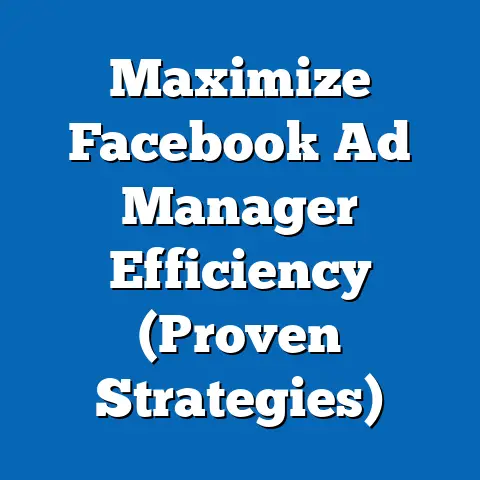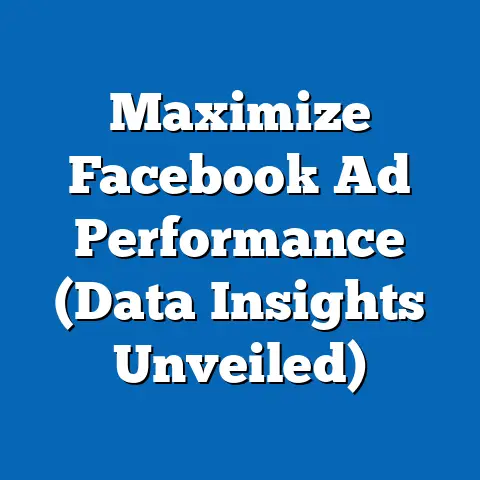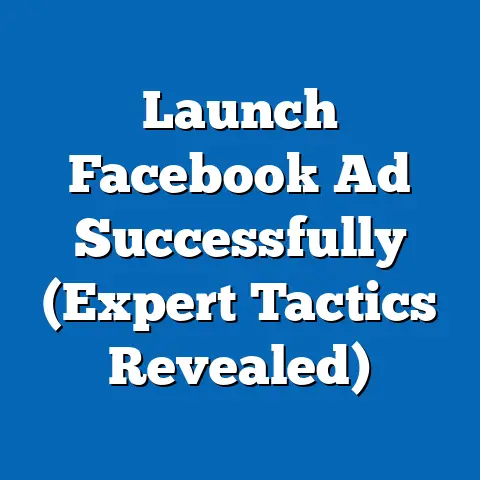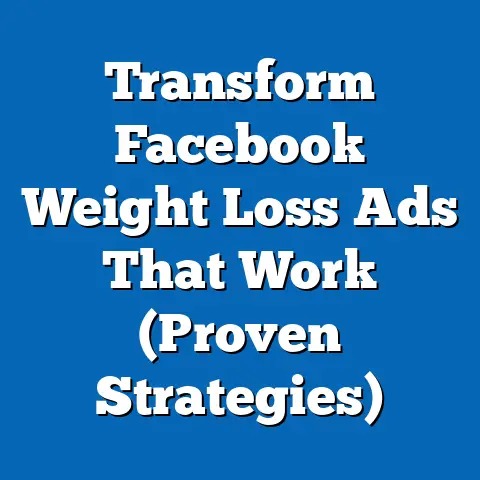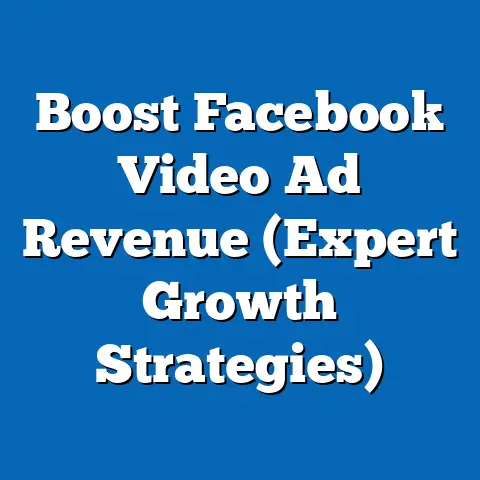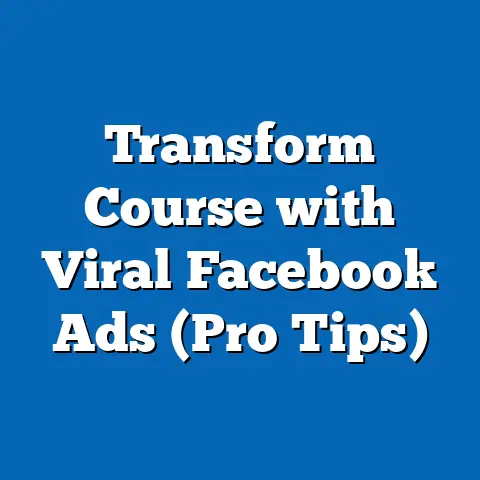Skyrocket Income with Facebook Ads (Proven Strategies)
Are you ready to unlock the secret to exponential income growth using the power of Facebook Ads? In today’s digital marketing landscape, Facebook Ads are more than just a tool – they’re a gateway to connecting with billions of potential customers worldwide. I’ve personally witnessed businesses, both large and small, transform their revenue streams by strategically leveraging this platform. In this article, I’m going to share the proven strategies that I’ve used and seen work, providing you with the knowledge to effectively use Facebook Ads and significantly increase your income.
Let’s dive in and explore how you can harness the power of Facebook Ads to achieve remarkable financial growth!
Understanding the Facebook Ads Ecosystem
What are Facebook Ads?
Facebook Ads are paid advertisements that appear on Facebook, Instagram, Messenger, and other platforms within the Meta network. Unlike organic posts, which rely on algorithms and user engagement to reach an audience, Facebook Ads allow you to directly target specific demographics, interests, and behaviors.
From my experience, the versatility of Facebook Ads is one of its greatest strengths. You’re not limited to just one type of ad; you can choose from a variety of formats to best suit your message and target audience.
Here’s a quick rundown of some of the most popular ad formats:
- Image Ads: Simple, visually appealing ads that feature a single image and accompanying text. These are great for showcasing products or services in a clear and concise manner.
- Video Ads: Engaging ads that use video to capture attention and tell a story. Video ads are particularly effective for demonstrating product features or sharing testimonials.
- Carousel Ads: Ads that display multiple images or videos in a scrollable format. This allows you to showcase a range of products or highlight different aspects of a single product.
- Collection Ads: Mobile-first ads that combine images, videos, and product information to create an immersive shopping experience.
- Lead Ads: Ads that allow users to submit their contact information directly through the ad, making it easy to generate leads.
- Instant Experience Ads: Full-screen, mobile-optimized ads that provide a rich and interactive experience for users.
The choice of ad format largely depends on your specific goals and target audience. For instance, if you’re launching a new product, a video ad might be the best way to showcase its features. On the other hand, if you’re trying to generate leads, a lead ad could be the most effective option.
The Unique Features of Facebook Ads
What truly sets Facebook Ads apart are its unique features, particularly its advanced targeting capabilities, audience segmentation options, and budget flexibility.
-
Targeting Capabilities: Facebook’s targeting capabilities are incredibly granular. You can target users based on demographics (age, gender, location), interests (hobbies, passions, favorite brands), behaviors (purchase history, online activity), and even life events (new job, recent move). This level of precision ensures that your ads are shown to the people most likely to be interested in your products or services.
-
Audience Segmentation: Beyond basic targeting, Facebook allows you to create custom audiences based on your existing customer data (e.g., email lists, website visitors). You can also create lookalike audiences, which are audiences that share similar characteristics with your existing customers. This is a powerful way to expand your reach and find new potential customers.
-
Budget Flexibility: Facebook Ads offers a high degree of budget flexibility. You can set a daily budget or a lifetime budget, and you can adjust your budget at any time. This makes it easy to control your ad spend and optimize your campaigns based on performance.
Targeting Capabilities: Facebook’s targeting capabilities are incredibly granular. You can target users based on demographics (age, gender, location), interests (hobbies, passions, favorite brands), behaviors (purchase history, online activity), and even life events (new job, recent move). This level of precision ensures that your ads are shown to the people most likely to be interested in your products or services.
Audience Segmentation: Beyond basic targeting, Facebook allows you to create custom audiences based on your existing customer data (e.g., email lists, website visitors). You can also create lookalike audiences, which are audiences that share similar characteristics with your existing customers. This is a powerful way to expand your reach and find new potential customers.
Budget Flexibility: Facebook Ads offers a high degree of budget flexibility. You can set a daily budget or a lifetime budget, and you can adjust your budget at any time. This makes it easy to control your ad spend and optimize your campaigns based on performance.
I remember working with a client who was initially hesitant to invest in Facebook Ads due to budget concerns. However, after demonstrating how effectively we could target their ideal customer and control their ad spend, they were amazed by the results. They saw a significant increase in leads and sales, all while staying within their budget.
Mastering the Facebook Ads Manager
The Facebook Ads Manager is your central hub for creating, managing, and tracking your ad campaigns. It’s a powerful tool that provides a wealth of data and insights, allowing you to optimize your campaigns for maximum performance.
Here are some of the key features of the Facebook Ads Manager:
- Campaign Creation: The Ads Manager guides you through the process of creating new ad campaigns, from selecting your campaign objective to defining your target audience and setting your budget.
- Ad Set Management: Within each campaign, you can create multiple ad sets, each targeting a different audience or using a different ad placement. This allows you to test different strategies and see what works best.
- Ad Creation: The Ads Manager provides a range of tools for creating your ads, including a library of stock images and videos, as well as the ability to upload your own creatives.
- Performance Tracking: The Ads Manager provides detailed data on your ad performance, including impressions, clicks, conversions, and cost-per-result. This data allows you to identify areas for improvement and optimize your campaigns accordingly.
- Reporting: You can generate custom reports to track your key performance indicators (KPIs) and gain insights into your audience behavior.
I always encourage new advertisers to spend time familiarizing themselves with the Ads Manager. It’s a complex tool, but once you understand its features and capabilities, you’ll be able to create and manage highly effective ad campaigns.
Key Takeaway: Facebook Ads offer a versatile and powerful way to reach your target audience and drive income growth. Understanding the different ad formats, unique features, and the Facebook Ads Manager is essential for success.
Next Steps: Explore the Facebook Ads Manager and familiarize yourself with its features. Experiment with different ad formats and targeting options to see what works best for your business.
Crafting a Winning Ad Strategy
Setting Clear Goals
Before you even think about creating your first ad, it’s crucial to define your goals. What do you want to achieve with your Facebook Ads? Are you looking to increase brand awareness, generate leads, drive website traffic, or boost sales?
Your goals will influence every aspect of your ad strategy, from your target audience to your ad creatives and bidding strategy.
Here are some common goals for Facebook Ad campaigns:
- Brand Awareness: Increase awareness of your brand among your target audience.
- Lead Generation: Collect contact information from potential customers.
- Website Traffic: Drive traffic to your website.
- Conversions: Encourage users to take a specific action on your website, such as making a purchase or filling out a form.
- Engagement: Increase engagement with your Facebook page or posts.
- App Installs: Drive installs of your mobile app.
I’ve learned that the more specific your goals are, the easier it will be to measure your success and optimize your campaigns. Instead of saying “I want to increase sales,” try saying “I want to increase online sales of my product by 20% in the next quarter.”
Identifying Your Target Audience
Once you’ve defined your goals, the next step is to identify your target audience. Who are you trying to reach with your ads? What are their demographics, interests, and behaviors?
Facebook’s Audience Insights tool is a valuable resource for researching your target audience. This tool provides data on the demographics, interests, and behaviors of people on Facebook, allowing you to gain a deeper understanding of your ideal customer.
Here are some of the key insights you can glean from Audience Insights:
- Demographics: Age, gender, location, education level, relationship status, job title.
- Interests: Hobbies, passions, favorite brands, pages they like.
- Behaviors: Purchase history, online activity, device usage, travel habits.
For example, let’s say you’re selling organic skincare products. Using Audience Insights, you might discover that your target audience is primarily women aged 25-45 who live in urban areas, are interested in health and wellness, and have purchased organic products online in the past.
This information will help you create highly targeted ad campaigns that are more likely to resonate with your ideal customer.
The Power of A/B Testing
A/B testing, also known as split testing, is a process of comparing two versions of an ad to see which one performs better. This is a crucial step in optimizing your ad campaigns and maximizing your return on investment (ROI).
In A/B testing, you create two versions of an ad that are identical except for one element, such as the headline, image, or call to action. You then run both ads simultaneously and track their performance to see which one generates more clicks, conversions, or other desired results.
Here are some elements you can A/B test in your Facebook Ads:
The key is to test one element at a time so you can isolate the impact of that element on your ad performance.
Key Takeaway: A winning ad strategy starts with clear goals and a deep understanding of your target audience. A/B testing is essential for optimizing your campaigns and maximizing your ROI.
Next Steps: Define your goals for your Facebook Ads. Use Audience Insights to research your target audience. Start A/B testing different elements of your ads to see what works best.
Creating Compelling Ad Content
Eye-Catching Visuals
In the crowded landscape of social media, your ad has just a few seconds to grab someone’s attention. That’s why it’s crucial to use eye-catching visuals that stand out from the noise.
Here are some tips for designing effective visuals for your Facebook Ads:
- Use high-quality images and videos: Blurry or pixelated images will make your ad look unprofessional.
- Choose visuals that are relevant to your target audience: Consider their interests and preferences when selecting images and videos.
- Use bright colors and bold fonts: These can help your ad stand out in the newsfeed.
- Showcase your product or service in action: This can help potential customers visualize themselves using your product or service.
- Use visuals that tell a story: Stories are more engaging and memorable than simple product shots.
I’ve noticed that ads with human faces tend to perform well, especially if the faces are smiling and expressive. People are naturally drawn to faces, so using them in your ads can help capture attention and build trust.
Persuasive Ad Copy
While visuals are important, your ad copy is what ultimately convinces people to take action. Your ad copy should be clear, concise, and persuasive, highlighting the benefits of your product or service.
Here are some tips for writing effective ad copy:
- Start with a strong headline: Your headline is the first thing people will see, so it needs to grab their attention and make them want to learn more.
- Highlight the benefits, not just the features: Focus on how your product or service will improve people’s lives.
- Use strong verbs and action words: These can help create a sense of urgency and excitement.
- Keep it short and sweet: People are more likely to read short, concise ad copy.
- Include a clear call to action: Tell people exactly what you want them to do, such as “Shop Now,” “Learn More,” or “Sign Up.”
I often use the “problem-agitation-solution” (PAS) formula when writing ad copy. This involves identifying a problem that your target audience is facing, agitating that problem by highlighting its negative consequences, and then presenting your product or service as the solution.
The Power of Storytelling
People are naturally drawn to stories. Stories are more engaging, memorable, and persuasive than simple facts and figures. That’s why storytelling can be such a powerful tool in your Facebook Ads.
Here are some ways to incorporate storytelling into your ads:
- Share customer testimonials: Let your customers tell their stories about how your product or service has improved their lives.
- Tell your own story: Share your journey as a business owner and explain why you’re passionate about what you do.
- Create a fictional story: Develop a short story that features your product or service in a positive light.
- Use visuals that tell a story: Choose images and videos that evoke emotion and create a connection with your target audience.
I worked with a local bakery that was struggling to attract new customers. We created a series of video ads that told the story of the bakery’s founding, highlighting the owner’s passion for baking and the community’s love for their products. These ads were incredibly successful, driving a significant increase in foot traffic and sales.
Key Takeaway: Compelling ad content combines eye-catching visuals, persuasive ad copy, and the power of storytelling.
Next Steps: Experiment with different visuals and ad copy to see what resonates most with your target audience. Try incorporating storytelling into your ads to create a deeper connection with potential customers.
Budgeting and Bidding Strategies
Daily vs. Lifetime Budget
One of the first decisions you’ll need to make when creating your Facebook Ad campaign is whether to use a daily budget or a lifetime budget.
- Daily Budget: A daily budget allows you to set a specific amount of money that you’re willing to spend on your ads each day. This is a good option if you want to run your ads continuously and control your daily ad spend.
- Lifetime Budget: A lifetime budget allows you to set a specific amount of money that you’re willing to spend on your ads over the entire duration of your campaign. This is a good option if you have a specific campaign end date and want to ensure that you don’t exceed your budget.
I generally recommend using a daily budget if you’re just starting out, as it gives you more flexibility to adjust your budget based on performance. However, if you have a limited budget and a specific campaign end date, a lifetime budget may be a better option.
Automatic vs. Manual Bidding
Another important decision you’ll need to make is whether to use automatic bidding or manual bidding.
- Automatic Bidding: With automatic bidding, Facebook automatically sets your bids to get the most results for your budget. This is a good option if you’re new to Facebook Ads or don’t have a lot of time to manage your bids.
- Manual Bidding: With manual bidding, you set your own bids for each ad auction. This gives you more control over your ad spend and allows you to optimize your bids based on performance.
I typically recommend using automatic bidding when you’re first starting out, as it’s easier to manage and can often deliver good results. However, as you become more experienced with Facebook Ads, you may want to switch to manual bidding to gain more control over your ad spend and optimize your bids for maximum performance.
Optimizing for CPC or CPM
When setting your bids, you’ll also need to decide whether to optimize for cost-per-click (CPC) or cost-per-impression (CPM).
- CPC Bidding: With CPC bidding, you pay each time someone clicks on your ad. This is a good option if you’re focused on driving traffic to your website or generating leads.
- CPM Bidding: With CPM bidding, you pay for every 1,000 impressions of your ad. This is a good option if you’re focused on increasing brand awareness or reaching a large audience.
The choice between CPC and CPM bidding depends on your campaign goals. If you’re focused on driving traffic or generating leads, CPC bidding is generally the better option. If you’re focused on brand awareness, CPM bidding may be more effective.
Scaling Ad Spend Effectively
As your ad campaigns prove successful, you’ll naturally want to scale your ad spend to reach even more potential customers. However, it’s important to scale your ad spend gradually and strategically to avoid wasting money.
Here are some tips for scaling ad spend effectively:
- Increase your budget gradually: Avoid making large, sudden increases to your budget, as this can disrupt your campaign performance.
- Monitor your results closely: Keep a close eye on your key performance indicators (KPIs) to ensure that your campaign is still performing well as you increase your budget.
- Expand your targeting: As you scale your ad spend, you may need to expand your targeting to reach a larger audience.
- Test new ad creatives: As you scale your ad spend, it’s important to test new ad creatives to keep your ads fresh and engaging.
I remember working with an e-commerce client who was eager to scale their ad spend after seeing initial success. However, they increased their budget too quickly, which led to a significant drop in their ROI. We learned that it’s crucial to scale gradually and strategically to maintain campaign performance.
Key Takeaway: Budgeting and bidding strategies are crucial for maximizing your ROI with Facebook Ads. Understanding the different options available and optimizing your bids based on performance is essential for success.
Next Steps: Decide whether to use a daily budget or a lifetime budget. Choose between automatic bidding and manual bidding. Determine whether to optimize for CPC or CPM. Scale your ad spend gradually and strategically to avoid wasting money.
Monitoring and Analyzing Ad Performance
Key Performance Indicators (KPIs)
Monitoring and analyzing your ad performance is essential for optimizing your campaigns and maximizing your ROI. To do this effectively, you need to track the right key performance indicators (KPIs).
Here are some of the most important KPIs to track for your Facebook Ad campaigns:
- Impressions: The number of times your ad was shown to users.
- Reach: The number of unique users who saw your ad.
- Clicks: The number of times users clicked on your ad.
- Click-Through Rate (CTR): The percentage of users who saw your ad and clicked on it.
- Cost-Per-Click (CPC): The average cost you paid for each click on your ad.
- Conversions: The number of users who took a desired action after clicking on your ad, such as making a purchase or filling out a form.
- Conversion Rate: The percentage of users who clicked on your ad and then took a desired action.
- Cost-Per-Conversion (CPC): The average cost you paid for each conversion.
- Return on Ad Spend (ROAS): The amount of revenue you generated for every dollar you spent on ads.
I always tell my clients to focus on the KPIs that are most relevant to their campaign goals. If you’re focused on driving traffic to your website, CTR and CPC are important metrics to track. If you’re focused on generating leads, conversion rate and cost-per-conversion are more important. If you’re focused on increasing sales, ROAS is the most critical metric to monitor.
Using Facebook Ads Manager and Facebook Analytics
Facebook Ads Manager and Facebook Analytics are two powerful tools that can help you monitor and analyze your ad performance.
- Facebook Ads Manager: This tool provides detailed data on your ad performance, including impressions, reach, clicks, conversions, and cost-per-result. You can use this data to identify areas for improvement and optimize your campaigns accordingly.
- Facebook Analytics: This tool provides insights into your audience behavior on your website and app. You can use this data to understand how users are interacting with your content and to identify opportunities to improve their experience.
I recommend using both tools in conjunction to get a comprehensive view of your ad performance and audience behavior. For example, you can use Facebook Ads Manager to track your ad performance and then use Facebook Analytics to see how users are interacting with your website after clicking on your ad.
Ongoing Optimization
Monitoring and analyzing your ad performance is not a one-time task. It’s an ongoing process that requires continuous attention and optimization.
Here are some tips for ongoing optimization of your Facebook Ad campaigns:
- Monitor your KPIs regularly: Check your KPIs at least once a week to identify any trends or areas for improvement.
- A/B test different elements: Continuously A/B test different elements of your ads, such as headlines, images, and ad copy, to see what works best.
- Refine your targeting: Adjust your targeting based on your performance data to reach the most responsive audience.
- Adjust your bids: Optimize your bids based on your performance data to maximize your ROI.
- Stay up-to-date with Facebook’s best practices: Facebook is constantly changing its ad platform, so it’s important to stay up-to-date with the latest best practices.
I’ve found that the most successful Facebook advertisers are those who are constantly monitoring their results, testing new ideas, and optimizing their campaigns based on data.
Key Takeaway: Monitoring and analyzing your ad performance is essential for optimizing your campaigns and maximizing your ROI. Track the right KPIs, use Facebook Ads Manager and Facebook Analytics effectively, and continuously optimize your campaigns based on data.
Next Steps: Identify the key performance indicators (KPIs) that are most relevant to your campaign goals. Use Facebook Ads Manager and Facebook Analytics to track your ad performance and audience behavior. Implement a process for ongoing optimization of your Facebook Ad campaigns.
Advanced Strategies for Scaling Income
Retargeting Strategies
Retargeting is a powerful strategy for re-engaging users who have interacted with your brand but haven’t converted. This involves showing ads to users who have visited your website, watched your videos, or engaged with your Facebook page.
Retargeting is effective because it allows you to reach users who are already familiar with your brand and have shown some level of interest in your products or services. These users are more likely to convert than users who have never heard of your brand before.
Here are some common retargeting strategies:
- Website Retargeting: Show ads to users who have visited your website.
- Video Retargeting: Show ads to users who have watched your videos.
- Facebook Page Retargeting: Show ads to users who have engaged with your Facebook page.
- Customer List Retargeting: Upload your customer list to Facebook and show ads to your existing customers.
I worked with an online clothing retailer who was struggling to convert website visitors into paying customers. We implemented a website retargeting campaign that showed ads to users who had viewed specific product pages but hadn’t added those products to their cart. These ads featured the products that the users had viewed, along with a special discount code. The retargeting campaign was incredibly successful, driving a significant increase in sales.
Custom and Lookalike Audiences
Creating custom audiences and lookalike audiences is another powerful way to expand your reach and find new potential customers.
- Custom Audiences: Custom audiences allow you to target users based on your existing customer data, such as email lists, website visitors, and app users.
- Lookalike Audiences: Lookalike audiences allow you to target users who share similar characteristics with your existing customers. This is a great way to find new potential customers who are likely to be interested in your products or services.
To create a lookalike audience, you first need to create a custom audience based on your best customers. Facebook will then analyze the characteristics of those customers and create a lookalike audience of users who share similar traits.
I’ve found that lookalike audiences are particularly effective for reaching new customers who are highly likely to convert.
The Facebook Pixel
The Facebook Pixel is a small piece of code that you can install on your website to track user behavior. This pixel allows you to track conversions, optimize your ads, and build custom audiences for retargeting.
Here are some of the key benefits of using the Facebook Pixel:
- Track Conversions: The pixel allows you to track conversions on your website, such as purchases, sign-ups, and form submissions.
- Optimize Your Ads: The pixel allows you to optimize your ads for conversions, showing them to users who are most likely to take a desired action.
- Build Custom Audiences: The pixel allows you to build custom audiences for retargeting, showing ads to users who have visited your website or taken specific actions on your website.
I always recommend installing the Facebook Pixel on your website as soon as possible. It’s a valuable tool that can help you track your results, optimize your ads, and scale your income.
Key Takeaway: Advanced strategies like retargeting, custom audiences, lookalike audiences, and the Facebook Pixel can help you scale your income with Facebook Ads.
Next Steps: Implement retargeting strategies to re-engage users who have interacted with your brand. Create custom audiences and lookalike audiences to expand your reach. Install the Facebook Pixel on your website to track user behavior and optimize your ads.
Case Studies and Real-Life Success Stories
To illustrate the potential of Facebook Ads, let’s take a look at some real-life success stories.
Case Study 1: E-Commerce Brand
An e-commerce brand selling handmade jewelry was struggling to reach a wider audience and increase sales. They implemented a Facebook Ad strategy that focused on:
- Targeting: Using detailed targeting options to reach users interested in handmade jewelry, fashion, and related interests.
- Ad Creatives: Creating high-quality images and videos that showcased their jewelry in a visually appealing way.
- Retargeting: Retargeting website visitors who had viewed product pages but hadn’t made a purchase.
The results were impressive. The brand saw a 300% increase in website traffic, a 200% increase in sales, and a significant improvement in their ROAS.
Case Study 2: Local Restaurant
A local restaurant wanted to attract more customers and increase reservations. They implemented a Facebook Ad strategy that focused on:
- Local Targeting: Targeting users within a specific radius of the restaurant.
- Ad Creatives: Using mouth-watering images of their food and highlighting special promotions.
- Call to Action: Encouraging users to make a reservation through the Facebook Ad.
The restaurant saw a 150% increase in reservations and a significant boost in their overall revenue.
Case Study 3: Online Course Creator
An online course creator wanted to promote their new course and generate more leads. They implemented a Facebook Ad strategy that focused on:
- Targeting: Targeting users interested in the course topic and related skills.
- Lead Ads: Using lead ads to collect contact information from potential students.
- Value Proposition: Highlighting the benefits of the course and the skills that students would learn.
The course creator generated over 500 leads in the first month of the campaign and saw a significant increase in course enrollments.
These case studies demonstrate the power of Facebook Ads to drive real results for businesses of all sizes. By implementing the strategies discussed in this article, you can achieve similar success and skyrocket your income.
Key Takeaway: Real-life success stories demonstrate the potential of Facebook Ads to drive significant results for businesses of all sizes.
Next Steps: Analyze these case studies and identify the strategies that are most relevant to your business. Implement those strategies in your own Facebook Ad campaigns and track your results.
Conclusion
Facebook Ads are a powerful tool for income growth, offering unparalleled reach, targeting capabilities, and flexibility. By understanding the ecosystem, crafting a winning strategy, creating compelling content, optimizing your budget, and continuously monitoring your performance, you can unlock the potential of Facebook Ads and achieve remarkable financial success.
I encourage you to take action and implement the proven strategies discussed in this article. The world of Facebook Ads is constantly evolving, so it’s important to stay curious, experiment with new ideas, and continuously optimize your campaigns based on data.
Share your experiences with Facebook Ads in the comments below, or reach out if you have any questions or need further assistance. I’m here to help you on your journey to skyrocket your income with Facebook Ads!
Call Out Section: FAQ
Q: Are Facebook Ads effective for small businesses?
A: Absolutely! Facebook Ads are effective for businesses of all sizes, including small businesses. The platform’s granular targeting capabilities allow you to reach your ideal customer, regardless of your budget.
Q: How much does it cost to advertise on Facebook?
A: The cost of Facebook Ads varies depending on several factors, including your target audience, ad creatives, bidding strategy, and campaign goals. However, Facebook Ads offers a high degree of budget flexibility, allowing you to control your ad spend and optimize your campaigns based on performance.
Q: How can I measure the success of my Facebook Ad campaigns?
A: You can measure the success of your Facebook Ad campaigns by tracking key performance indicators (KPIs) such as impressions, reach, clicks, conversions, and return on ad spend (ROAS).
Q: What are the common mistakes to avoid when running Facebook Ads?
A: Some common mistakes to avoid when running Facebook Ads include:
- Not defining your goals clearly
- Not identifying your target audience
- Using low-quality visuals
- Writing weak ad copy
- Not A/B testing your ads
- Not monitoring your ad performance
- Not optimizing your campaigns
By avoiding these mistakes and implementing the strategies discussed in this article, you can maximize your ROI and skyrocket your income with Facebook Ads.

